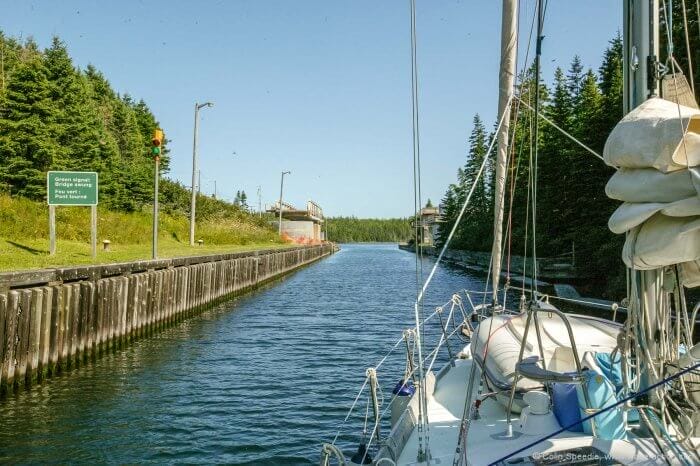
When we entered the Bras d’Or Lakes last year it was pure business for us, as the end of the season was beckoning and we planned to haul Pèlerin for the winter at Baddeck. Which is never the way to take in a place in all its glory as things are too rushed, deadlines approach with unnerving speed, lists are being made and the phone, silent for so long, starts to ring relentlessly. Which is not cruising, but commuting…
But even so, the place worked its magic on us and even as we prepared to bid a sad farewell to Pèlerin, we were mentally noting the places we’d like to explore on our return.
Getting ready to leave a boat in a far distant land for months on end is never easy, but with careful preparation and safe hands at the yard, once you have done your best it’s time to leave without a backward glance.
We weren’t unduly worried, as we were confident that she was indeed in safe hands with the great team at Baddeck Marine, who would look after her as if she were their own. And so it proved, so when we returned this summer we were able to take to the water once more without any major issues, ready to start exploring the Lakes at our leisure.
Anticipation Can Ruin Reality…
When everybody you meet who has visited a cruising ground raves about it, it can cause you to raise your own expectations too high, which can only set a place up for a fall. So it would have been easy for us to tumble into that trap with the Bras d’Or Lakes as we had heard nothing but positive things about them since we had left Britain nearly ten years ago. As a result, they were high on our bucket list of places not to miss.
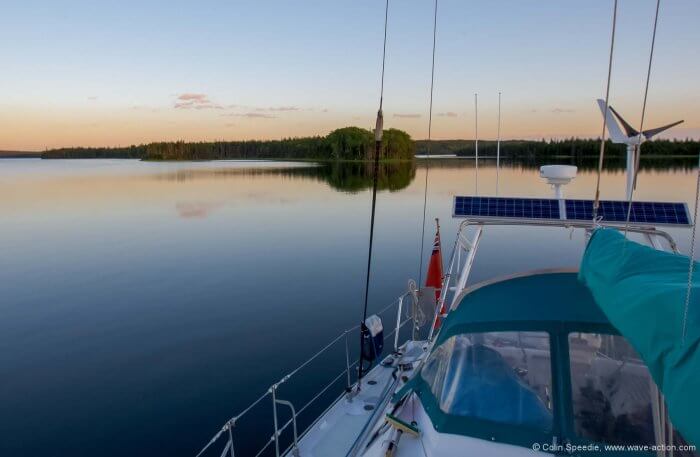
Happily, the Lakes lived up to their reputation, being beautiful, far from busy and with an amazing selection of secure, remote anchorages. Other pluses include the sheltered waters—even when it’s blowing hard there’s next to no sea running—the tiny tidal range and the lack of any strong currents except in the channel between the main Lakes and the northern exit to the sea.
For those of us who have sailed the Nova Scotia or Newfoundland coasts to arrive here, challenged by the cold, damp fog that regularly besets those shores, the warm and relatively fog free nature of the Lakes also offers a welcome respite.
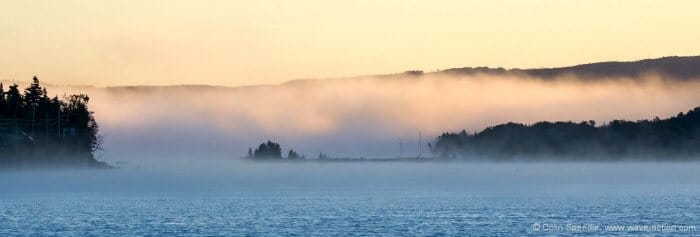
There are easily accessed pitstops to refuel and stock up on supplies at St Peter’s Inlet and Baddeck. The local Lions Club run the marina at St Peter’s, where yachtsman’s friend Gerry Gibson will look after you.
Baddeck Marine can offer most technical services and a range of spares should you need support. In short, it’s an almost perfect small cruising ground for a few weeks (at least), especially if you are in no hurry or are drawing breath on your way back from Newfoundland or even Greenland.
Fine Anchorages
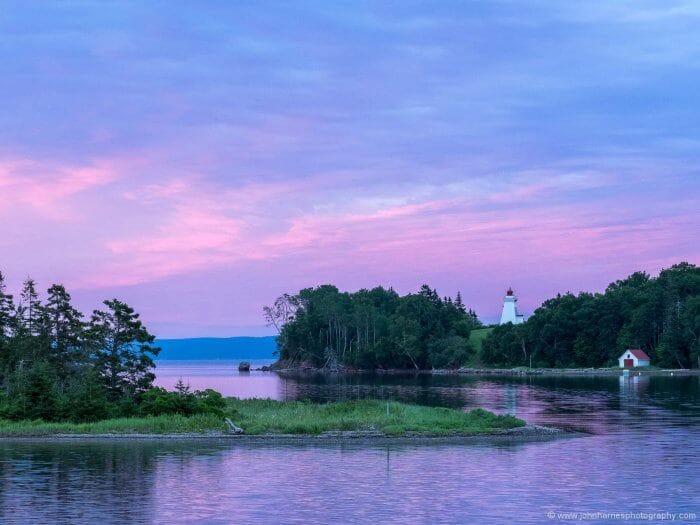
Some of the anchorages are justifiably famous, such as Maskell’s Harbour, an almost landlocked pool with space for a substantial fleet of boats. Of course, such places tend to become over popular, but in the case of the Lakes that’s a relative thing and we never shared the place with more than half a dozen boats at the height of the season. Besides, if you’re really reclusive it’s easy enough to get away from it all and have an anchorage to yourselves as we did on many occasions.
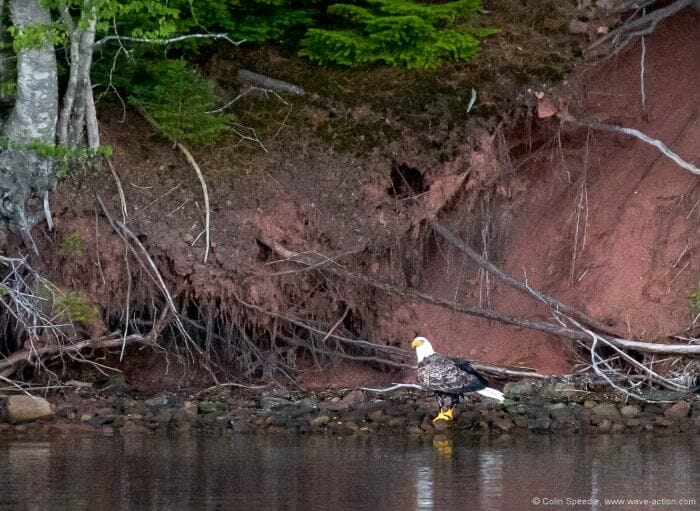
We enjoyed total peace and quiet during a spell of windy weather in both Indian Cove and Deep Cove in the Washabuck River, the latter almost a hurricane hole, perfect for our shoal draft Ovni.
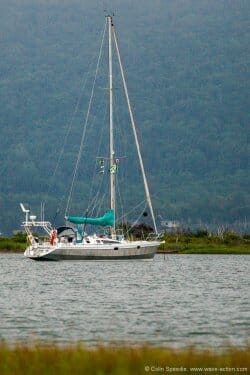
We also had several lovely days in the Indian Islands, close to the main settlement of the Mi’kmaq, the local First Nations people, disturbed only by sparring bald eagles and ospreys. And so it was with dozens of other inlets and coves, most of them almost undeveloped and traffic free, though we did notice an ominous rash of real estate signs on the shore line in many beautiful coves, especially those closest to ‘civilization’.
Many of us judge the beauty of a place by how closely it resembles its native state, prior to man’s arrival. It’s easy to get sniffy about this and view the sight of a lone pylon as a sure sign of ruination, whilst at the same time enjoying the conveniences of the nearby shops and laundry facilities that the power line is going to. Perhaps the sanest way to view this is somewhere in between, in which case the Bras d’Or Lakes should definitely be on your ‘must visit’ list.
The Call of Home
Emigrants always carry home close to their hearts, as evinced by their habit of naming places after their lost homeland on arrival. So passing through the Barra Narrows between the great and little Bras d’Or Lakes looking up at the pretty white painted Iona Church took us back to where many of the local families originated from, the Western Isles of Scotland.
Ashore the Gaelic influence is strongly felt, too, with a nightly ceilidh in Baddeck, and the annual Celtic Colours Festival on the island each autumn that hosts fiddlers, pipers and story tellers from around the Scottish diaspora.
None of it is just a cheesy recreation of a lost era, either—Cape Breton continues to produce some of the finest traditional musicians anywhere in the world, who keep the spirit of their origins current and vibrant in the very best of ways. As autumn also offers some fine weather to watch the changing colours of the trees, too, maybe that’s yet another reason to visit this charming place.
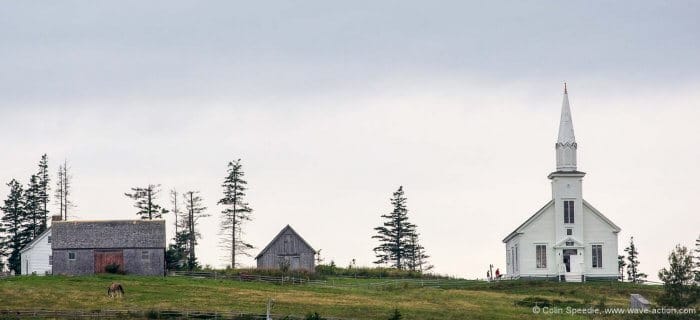
Meeting Friends
During our stay in the Lakes we had arranged to meet up with our German friends Martin Hollenhorst and Lydia Goll, owners of the Boreal 52 Cheglia who were travelling through on their way to Newfoundland. Being connoisseurs of fine food, they had already identified a suitable venue for us to get together at the Cape Breton Smokehouse, on the shores of Little Harbour, yet another almost landlocked pool with almost total shelter from wind of any direction.
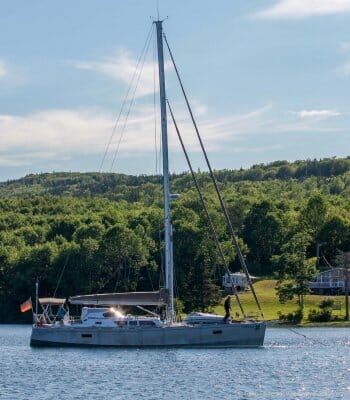
Now I last saw Cheglia as I left her in the marina in Porto, Portugal almost a year before, since when she had put quite a few miles under her belt.
Having assisted Martin and Lydia with her build I (as always) feel a strong connection to this powerful boat, just as I had with Christopher and Molly Barnes’ Sila and all the other Boreals that I have worked with, so to watch her come powering through the narrow entrance channel after crossing an ocean was quite a moment.
Anyone who thinks that a yacht is just a machine is missing the point. Sailors have always known that the craft that carry them safely across an ocean have a soul—who amongst us hasn’t patted a cockpit coaming and muttered “thanks for looking after us” after a torrid night watch?
Having been so closely associated with her and sailed aboard her, too, I feel that same mix of affection and respect that all good owners have for their craft. To see her again and to hear Martin and Lydia’s tales of their travels was a real tonic.
Good Food Too
As was the fine meal we enjoyed at the Smokehouse, which is an extraordinary place, a giant log cabin with amazing views over the anchorage. Owned by a charming German couple who arrived here on their own liveaboard ketch and decided to stay, we were the only guests that night and so had the best views over Pèlerin and Cheglia, followed by a quiet evening on the pontoon below watching a resident beaver doing his rounds as the sun went down. Even the substantial mosquitoes couldn’t mar such a special evening.
And I wish that the slab of house smoked salmon that we bought to take with us should have been never ending, just exquisite.
Hi Colin,
Another fine piece of writing.
Especially timely as we plan to come down from Newfoundland next season and partake of what Nova Scotia has to offer: which sounds impressive. Thanks for your additional notes enticing us.
One comment: I have been in touch with the Canadian Border people and they are every bit as reasonable as you report and extremely nice to deal with. Quite a breath of fresh air after multiple experiences to the contrary in other countries.
An addition to your 12-mile limit protocol: when told of this possibility, I was strongly reminded (it sounded like one or more sailors had forgotten to do so) that, after the 12 mile trip offshore, one needed to check in just as if you were arriving to CA for the first time. This is what re-sets the clock. It might be possible to do this by phone if you have established a relationship with the people of your local office as we have done, but I expect this kind of flexibility is dependent on many factors.
Another possibility (also mentioned by the Border officials) is to sail to the St. Pierre and Miquelon Islands which are French.
My best, Dick Stevenson, s/v Alchemy
Hi Dick
you’ll love Nova Scotia, I’m sure.
You do have to check-in as if arriving for there first time after you re-entry voyage, as we did at St Peter’s. And I’ve also heard that visiting the French islands is another option, a very pleasant one, too, I’m told!
The helpful and friendly Customs staff make this all very straightforward – another big thumbs-up for Canada! See you there, I hope.
Best wishes
Colin
Nova Scotia packs an awful lot of variety into a relatively small space. Just in Cape Breton alone, you have three totally different environments – the Highlands, the Bras d’Or Lakes, and the south shore – that can keep you busy for months with only a couple hundred miles of sailing.
I’ve been around Cape Breton twice, both times by road, and while this is does let you see it in a hurry, I think the place really does call for a more leisurely trip by boat. Its history and culture are heavily laden with nautical themes, and there is SO much that you miss at 80 km/h. Spending an entire season, May to September, to sail the whole island would be totally justified.
Hey Matt, Colin, Dick and John….
We’re in the process of putting the final touches to bring a boat home to the US via the Viking Route. In an ideal world we have time to enjoy the many experiences along the way….which brings me to the Canadian topic mentioned here. I’ve read everything I can find online and the CBSA website per visiting private boats – 12 month limitation, need to report if we plan to store the boat etc. What I’ve not been able to find is text stating the ability to leave Canadian waters per 12 miles to reset the clock and checking back in. If this is truly possible…we might spend 2 seasons in CA if that is possible before moving on to the US for it’s final home.
I welcome any assistance so I’m 100% confident we’re abiding by the rules and sentiment.
Hi Stewart,
I’m afraid there is no 100% confidence in this area since as I understand it it’s entirely up to the individual officer. I have also not heard of the 12 mile option being used lately. That said, you may be able to stay two seasons by hauling the boat and having work done at a yard, but again, that’s decided in each case. The other area of difficulty is clearing into Canada in the north which must be prearranged well ahead of time and whether or not that permission is even going to be granted seems to be up in the air. We are a tad sensitive about sovereignty, particularly in the north, at the moment.
Bottom line on all of this, you need to communicate with CBSA and do exactly what they tell you. Don’t rely on forums or what has happened in the past. We are in a different world now. And above all, don’t just turn up in Labrador and hope it will be OK. That course of action has ended badly in the past and these days the chances of CBSA enforcing the letter of the law are much higher than there were. I suspect their elbows are up too.
Hi Stewart,
Firstly: the Viking route is a great way to cross from Europe. The longest jump is, I believe, around 750nm so most of the passage is under predicted weather, but the best of all are the cruising destinations of the Faroes, Iceland, and Greenland fetching up on Newfoundland. We took a whole season. Be aware there is the relatively recent CCA Passage Guide to the Viking Route (which would have saved us countless hours of preparatory research) and that the CCA Guide to Newfoundland is recently extensively updated. Both will have entry information (commensurate with their publication date) to get you started.
I agree with John that officers have great latitude. This can be a problem or a good thing. Our preparatory research indicated we could call in on the phone when we arrived (2017) in St. Anthony on our arrival from Greenland. This was not the case, if memory serves, we thought we could call in from any port, but it turned out that we needed to do it from specific ports. After some time on the phone describing our research and our wish to visit L’Anse aux Meadows (Viking settlement) while in the area, the officer used her personal discretion to give us permission to enter the country. Strict following of the rule would have had us being told to sail a fair distance to, I think, Lewisporte. Had that been the case we would have likely missed the out-of-the-way, but excellent cruising on the northern arm of Newfoundland.
I think you are off to a good start in that you are researching how to make your entry to Canada go smoothly. Document your efforts, perhaps in your Ship’s Log. It has been our experience in entering many countries by boat that you will get cross-wise of officials at some point, but that what most officials care about is whether you are operating in good faith: they know it is often confusing. Being able to describe your efforts to do the right things makes a big difference. That said, there is always a chance that you will get an official who got up on the wrong side of the bed: but our experience is that entry goes well.
In addition to the CBSA research, if you know your area of entry, I would contact the local CBSA directly. As to extending your visit, I know of two boats to have executed the 12nm offshore and return (~~2018-19 or so). Both had OK’d it ahead of time with their local CBSA office and it went off without a hitch. We were in the Canadian Maritimes for 3+ years cruising (and the boat stuck on the hard for 2 years of covid) and we used St Pierre et Miquelon as our exit from CA (no hardship there as we were “going to” France and its wonderful food) and returned to CA to check-in in Fortune, Newfoundland. (Again, how easy it is to get cross-wise: the first time we did this we went in high winds to the marina to the marina and walked over to check in as we were suggested to do by one official on the phone. Checking in on foot, we were told by another official to get the boat and tie up on the wharf in front of the office: a wharf more designed for ferries than recreational sailboats. As it was blowing 30kn, we asked for some leeway, and received it: and so it goes. The next time we tied up on the wharf.
Have a great trip and, I expect, everything will go smoothly.
My best, Dick Stevenson, s/v Alchemy
Hi Dick and Stewart,
That’s great Dick, thank you. However I caution that as of today that’s all ancient history.
I think few Americans really understand how different things are today in Canada, so anything that happened before about January of this year may not be applicable today. My advice is to follow the regulations to the letter, and not rely on the past history of friendliness and flexibility exhibited by the Canadian Border Service Agency for any exceptions.
Here’s a list of reporting harbours: https://www.cbsa-asfc.gc.ca/do-rb/services/trsm-sdtm-eng.html
Note there are none on the Labrador coast, other than Goose Bay, which is not practical.
Be very clear that if you want to make your first landing in Canada at anywhere other than the ports listed above you must have prior written approval from CBSA.
For those who would like a clear, well reasoned, and unemotional explanation of the current situation in Canada I can’t recommend this video too highly: https://www.youtube.com/watch?v=V11qNDDElZw
Hi John,
Agreed.
I continue to be in and out of Canada yearly as we wander around the Great Lakes and all is done by phone after some paperwork is filled out ahead of time. This has been seamless so far, as has the return to the US.
I will be curious to hear how things unfold. We will be sailing Lake Superior, but are planning all US destinations after last season much of which was in Canada. I am a member of the Great Lakes Cruising Club whose active forum will quickly publish difficulties members might experience.
I hope it is like when we were in Turkey and other countries in the Middle East where it was clear that the US’s policies were unpopular, sometimes very unpopular, but person to person we felt welcomed.
My best, Dick
The first two pictures seemed to have broken links for me. Otherwise great article.
Hi Ted,
If you are referring to the first two graphics under the opening photo, one is an imbedded video and the other an imbedded Google map. I’m guessing you have an aggressive security setting enabled, or possibly an ad blocker turned on that is preventing these two imbeds loading. What browser are you using and are you using an ad blocker or special security plug in.
Hi Again, Ted,
One other thing that may help is to refresh your browser window while holding the shift key down (if on a computer).
Well for whatever reason when I just went back they were displaying properly. As much as anything if there was a problem I would want you to know so you could fix it. Since it’s all great.
Very timely, as we’ve been looking to get some land fronting on the lake here. We just missed a place midway between Maskell’s and Iona. If you aren’t so close to the few populated spots, it’s a reasonable place to get the mooring of your dreams. I also note that one of the finest free cruising guides I’ve ever downloaded is available for Cape Breton waters and is highly detailed (although not meant to replace charts): http://cruising-cape-breton.info/
Hi Marc
well it is indeed a lovely area! And yes, the Cape Breton guide is very handy.
Even the winters aren’t too bad, I’m told, and people find plenty to do.
Best wishes
Colin
Greetings Colin,
Enjoyed your article an great pictures too. Looks like you found some decent weather. It certainly can be variable in this area and July of 2011 when we were there was one for touques and constant foul weather gear. Bloody cold but the people we met certainly welcomed us warmly and we did enjoy the place. By contrast we had a very warm summer sailing the south shore of Newfoundland in 2012. Now we are in the Med and it will be some time before sailing these colder waters again. We did find that having a centerboard was very handy and a well insulated aluminum hull even more of a help.
Cheers, Leigh sv White Cloud
Hi Leigh
you’re right that the weather can be variable – summer came late last year, for example, but for the most part we were very lucky with the weather.
Having a well insulated aluminium boat is definitely the way to go in such climates, keeping you warm and dry. It’ll keep you cooler in the Med, too, which can be very hot.
Best wishes
Colin
To Colin and John (who is close by in Lunenburg), where is the closest port where i could lay the boat on hard land for the winter ? Coming from Quebec City, i would want to maximize the time spent cruising Lac Bras d’or on two seasons.
thanks
Hi Andre,
If in Cape Breton, Baddeck Marine is a good option. If you prefer to be closer to Halifax, then we are very happy with East River Shipyard, where we lay up each winter.
http://www.baddeckmarine.com
https://www.eastrivershipyard.ca
Hi Belinda
as John suggests above, for the short stay Baddeck Marine or St Peter’s Lions Club Marina near the southern entrance to the lakes would both be worth trying.
For an over winter storage, the again, like John, I’d recommend East River Shipyard in Nova Scotia, which could certainly handle your boat, size wise.
Best wishes
Colin
Gerry, the fellow who runs St. Peter’s, is a bit of a local legend who goes out of his way to accommodate vistors’ needs. Five stars for Gerry.
I still concur with East River Ship Yard, as we have hauled there for three winters with a steel pilothouse cutter of some 16 tons in weight, especially as a Hylas 47 is a big boat and they have a 70 tonne Travelift with a 150 tonne one awaiting assembly and a new well for it currently being built.
But I would do my own winterization there, because it’s not just the things done differently down East, but the things not done at all that have troubled me on occasion. There are certain jobs I do not care to delegate, and that is a big one. John may have thoughts here on the topic as he’s at the same yard as me.
Baddeck is also a good option as they have a very nice marine repair shop and we’ve known others with big boats who have recently hauled out there for similar reasons to your own. The difference between the two is that East River is a 45-minute drive to the Halifax airport, while Baddeck is in the middle of Cape Breton. Very scenic, very charming, but probably a six or seven-hour drive at minimum to near Halifax, and that’s in good weather. Hope this helps.
Hi Belinda,
Good to hear you are on this side of the pond. You are heading for some great cruising grounds.
We over-wintered in Shining Waters Marina and Boatyard (2018-19) in the same general area as East River and were well taken care of. They allowed us to do all the work we wished without problem and did have good help when we needed it. I am sure ER would take good care of you as well.
Shining Waters is, to my mind, very like Suffolk Yacht Harbour: a place for good work and also a place where we met lots of lovely and generous locals: something that enhances Ginger’s and my cruising experience greatly. My casual observation on ER is that people come in, do work, and exit, but there are far more experienced readers who can comment on whether that observation is accurate and suggest other differences.
My best to Geoff,
Come back with questions, Dick Stevenson, s/v Alchemy
Ps. Whichever you choose there are some superb canvas and cushion people in the area that we took advantage of.
Hi Belinda,
Be aware, when choosing a location for leaving Onegin in the Atlantic Canadian Maritimes in Aug. that there is a chance for a hurricane, or the still potent remnants thereof. We watched two come close in our 3 years in the area.
My best, Dick Stevenson, s/v Alchemy
Hi Belinda,
I would agree with Colin’s recommendations, and although I have no first hand experience, I hear good things about Shining Waters as recommended by Dick. And as Dick says, I would make my plans with the possibility of a hurricane strike in mind.
Any thoughts from this group on the west coast of Cape Breton Island or possibly circumnavigating Cape Breton Island. The boat is a 55′ steel trawler that draws 5′ and the timeframe is late July and August. Thanks
Hi James,
The best resource by far is the CCA Nova Scotia Guide edited by my friend Wilson Fitt. Wilson has just finished the latest updated edition and it’s now available.
Thanks. I have the 2022 edition and will look for the new one.
Hi James,
The 2022 edition is the most recent version although you can find updates at https://cruisingclub.org/book/nsguide/updates. I am in the early process of preparing a 2026 edition and will welcome any suggestions or updated information you may be able to provide.
The west coast of Cape Breton Island is very scenic but Port Hood and Cheticamp are the only places that can be easily entered in strong onshore winds. The others should only be attempted in fine weather. Once in though, you will find yourself in the heart of traditional Scottish Cape Breton with wonderful music and very friendly people.
Rather than circumnavigating the Island on the outside, I would cut through the middle via the Bras d’Or Lakes. Enter from the north through Great Bras d’Or Channel or from the south by the St Peters Canal. The Lakes have a well-earned and fully justified reputation as one of the finest cruising grounds in eastern North America, much nicer than the cold, grey North Atlantic outside!
Your boat will be entirely suitable, and the timing is perfect in terms of weather.
Wilson
Hi James and Wilson,
Sorry, I got that wrong on the new edition. I was clearing thinking of Labrador, which you (Wilson) just finished. And thanks for the fill on the west coast. I have been by several times but never cruised it.
Wilson,
Thanks for the thoughtful reply. Apologies for my lack of precision, but my plan is to do as you say via the Lakes and the West Coast. We were in the Bras d’Or Lakes 15 years ago and are looking forward to a return. Thinking clockwise might be preferred for wind and seas.
Jim